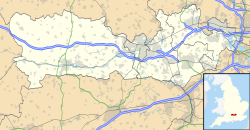History
Beaumys Castle was a manor in the parish of Swallowfied, given to Sir Nicholas de la Beche in 1335. De la Beche received a licence to crenellate in 1338 and produced a fortified manor house. [1] The castle was rectangular, protected by earthworks approximately 130m by 110m across, surrounded by a water-filled moat, with the castle accessed from an entrance to the north-west. [2]
De la Beche died, leaving the manor to his wife Margery, who in turn remarried, [1] to Thomas Arderne. [3] On Arderne's death in 1347, however, John de Dalton and a small group of followers broke into the castle, where they killed Michael de Poynings, an important nobleman; terrified Lionel, the son of Edward III who was staying there at the time; stole £1,000 worth of goods, and seized Margaret, who, as a wealthy widow, was forced to marry John.
The surrounding manor was broken up in 1420; the surviving earthworks are a scheduled monument. [4]
This page is based on this
Wikipedia article Text is available under the
CC BY-SA 4.0 license; additional terms may apply.
Images, videos and audio are available under their respective licenses.
